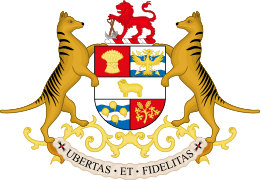Tasmanian state election, 2002
| | |||||||||||||||||||||||||||||||||||||||||||||||||||||||
| |||||||||||||||||||||||||||||||||||||||||||||||||||||||
| |||||||||||||||||||||||||||||||||||||||||||||||||||||||
| |||||||||||||||||||||||||||||||||||||||||||||||||||||||
A general election for the Tasmanian House of Assembly was held on Saturday 20 July 2002. The Labor government led by Premier Jim Bacon was seeking a second term against the Liberal Party of Australia Opposition headed by Opposition Leader Bob Cheek. The election was marked by a strong swing to both the Labor Party and the Tasmanian Greens at the expense of the Liberals, with Cheek losing his own seat.
Bacon and the Labor Party campaigned on a platform of revitalising the state after the 1990s-era economic reforms of successive Liberal governments, while maintaining law and order and a strong economy, and promoting tourism in particular. In response, Cheek and the Liberals claimed that the government had abandoned small business and promised a wide range of spending initiatives - something that was seized upon by Bacon as a means of attacking the Liberals' economic credentials. The Tasmanian Greens, under leader Peg Putt, campaigned as an alternative to both major parties, concentrating on environmental issues, which are often an area of bipartisan agreement among the Tasmanian major parties.
The results of the election were somewhat unexpected. The government retained its 14 seats in the 25-member parliament and recorded a swing in their favour in all five electorates. The Liberal Party had held ten seats before the election, but lost three to the Greens, who subsequently went from one to four seats. The Greens gained 18.1% of the statewide vote, their highest on record. In the Hobart-based seat of Denison, the Greens polled 24.5%, outpolling the main Opposition Liberal Party.
The election had major impacts on both the Liberal Party and Tasmanian Greens, while leaving the governing ALP largely unchanged. The Liberal Party elected a new parliamentary leader, MP Rene Hidding, from the Lyons, following the defeat of its previous leader, Bob Cheek who lost his seat in the Liberal rout.
In contrast to the misfortune of the Liberal Party, the election saw the unexpected revival of the Greens. The reduction of the size of the Assembly in 1998, from 35 to 25, had increased the quota necessary to win a seat to 16.7%. Both major parties portrayed this as a way to cut the costs of government, but the Greens saw it as an attempt to eradicate them. At the 1998 election, all of their MPs except one, Peg Putt, were defeated. However, they managed to markedly increase their vote in the 2002 poll, and picked up three new MPs, Kim Booth, Nick McKim and Tim Morris.
Results
|
Tasmanian state election, 20 July 2002 | ||||||
|---|---|---|---|---|---|---|
| Enrolled voters | 332,473 | |||||
| Votes cast | 311,637 | Turnout | 93.73 | –1.28 | ||
| Informal votes | 15,167 | Informal | 4.87 | +0.96 | ||
| Summary of votes by party | ||||||
| Party | Primary votes | % | Swing | Seats | Change | |
| Labor | 153,798 | 51.88 | +7.09 | 14 | ± 0 | |
| Liberal | 81,185 | 27.38 | –10.67 | 7 | – 3 | |
| Greens | 53,746 | 18.13 | +7.95 | 4 | + 3 | |
| Democrats | 2,019 | 0.68 | –0.21 | 0 | ± 0 | |
| Socialist Alliance | 722 | 0.24 | +0.21 | 0 | ± 0 | |
| Tasmania First | 529 | 0.18 | –4.92 | 0 | ± 0 | |
| Independent | 4,471 | 1.51 | +0.52 | 0 | ± 0 | |
| Total | 296,470 | 25 | ||||
Distribution of seats
See also
- Members of the Tasmanian House of Assembly, 2002-2006
- Candidates of the Tasmanian state election, 2002
References
- Tasmanian Parliamentary Library: 2002 election results
- Voting by Division from Adam Carr's Electoral Archive
- Australian Parliamentary Library research note


